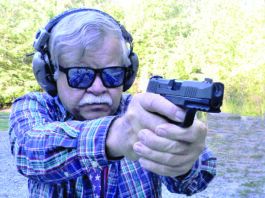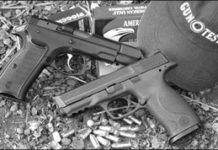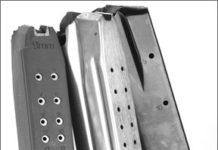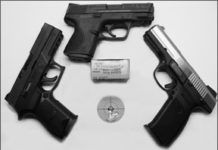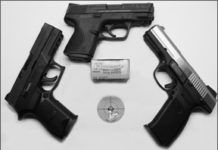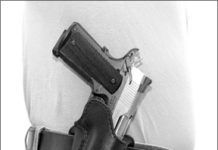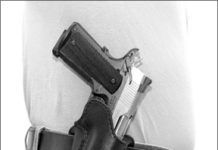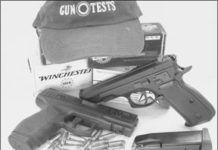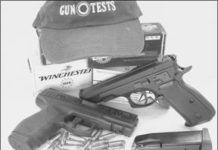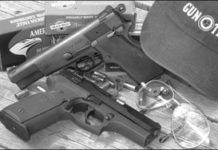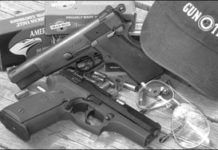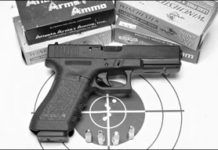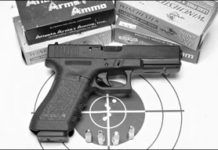Two Big 9mms: High-Capacity, Full-Size Self-Defense Picks
High-Capacity Full-Size 9mms: CZ-USAs Phantom Shows Up
If we were to list the reasons for the boom in popularity of the semiautomatic handgun, high capacity would be at the top. The highest-capacity pistols are typically chambered for 9mm because the cartridges are slender and you could pile a lot of them on top of each other. In this test we will shoot three 9mm pistols that subscribe heartily to the plan of carrying as many rounds as the frame will permit. With the rush on guns and ammo we actually had some difficulty putting this test together, but we found everything we needed at Jim Pruett's Anti-Terrorist Headquarters.
Each pistol represents the highest capacity available from the respective manufacturer. The $749 Springfield Armory XDM9211HCSP is the 9mm version of the largest-framed Croatian police pistol that was introduced chambered for 40 S&W just a few months ago. The $695 CZ SP-01 Phantom No. 91158 is a fresh variation of the venerable CZ75 pistol. It features a polymer frame with interchangeable panels at the rear of the grip. Our third pistol is a benchmark among high-capacity 9mm pistols. The $680 Glock 34 takes the large-receiver Model 17 and tops it with a longer barrel and adjustable sights. The design of each of these guns has been influenced by the demands of the Practical Shooting crowd and should make ideal weapons for home defense, duty carry, or open carry for the civilian.
With the possible exception of the CZ pistol, the operation of each gun was a known quantity. So our evaluation will spend most of its time and ink on performance and describing a test drive. With maximum available sight radius available on each gun (another benefit of the full-size pistol), we chose to record accuracy data from a distance of 25 yards. For support we used a $49 Caldwell Rock Jr. shooting rest beneath the dust cover of each pistol and a $19 pre-filled Caldwell Elbow Bag to support our hands, both from battenfeldtechnologies.com. The Rock Jr. proved stable without being unnecessarily heavy. The pre-filled bag stayed tight and didn't compress so much that we had to reset the guns after every shot. With these tools we were able to do our best despite the gusting winds racing across the Texas plains.
To learn more about the rapid-fire capability of each weapon, we created an action test. We placed three targets downrange in a triangular pattern. The central target was directly in front of the shooter 50 feet downrange. The flanking targets were each 30 feet downrange and 15 feet from the center line. The targets were police training targets with a 3-inch circle of Caldwell Orange Peel target pasted at dead center. The drill was to raise the pistol from a tactical low ready (a drop of the sights from the target low enough to give view of the subject's hands), and engage the targets from left to right with two shots each. Beginning with a full magazine, the drill was fired in six-shot strings until the magazine was empty. The test was concluded when we had exhausted two full magazines worth of ammunition. Our pace was held to about the same for each pistol. We wanted to see consistent hits and collect shooter feedback. This means what the shooter saw and what adjustments had to be made to land the required hits.
Test ammunition consisted of the latest generation of Black Hills 124-grain FMJ remanufactured ammunition and new manufacture 115-grain FMJ rounds. The 124s were used in our multiple-target drill. We also fired 124-grain Speer Gold Dot Hollowpoints, which gave us a scare during our chronograph of the Glock pistol. Without warning one of the rounds appeared to overpressure, causing the G34 to jump violently. Recorded velocity of that round was 1311 fps. This was more than 100 fps faster compared to previous shots through the chronograph. We did not recall a similar experience when firing from the bench, so we do not think this interfered with the accuracy of our data. Range conditions offered amenable temperatures but gusting winds and shifting light. Let's see what we learned about these three high-capacity sidearms.
Three Small 9mm Pistols Redux: Sig Sauer, S&W, and Ruger
Three Small 9mm Pistols Redux: Sig Sauer, S&W, and Ruger
Mixed Bag in Self Defense: Partner Handguns Fight It Out
Mixed Bag in Self Defense: Partner Handguns Fight It Out
A Brace of Full-Size 9mms: Go With CZs 75 B Single Action
A Brace of Full-Size 9mms: Go With CZs 75 B Single Action
9mm Semi Shootout: DA or SA? We Like Stoegers Cougar 8000
9mm Semi Shootout: DA or SA? We Like Stoegers Cougar 8000
Full-Time-Double-Action 9mms: We Like SIG Sauer, H&K, Glock
In this test we shot three double-action-only pistols designed for duty or personal self defense. Medium to large in size, they carry few levers, and this snag-free characteristic also makes them attractive for concealed carry. Two of the three guns, the $879 Heckler & Koch P2000 LEM V2 and Sig Sauer's $749 P250 Two-Tone, utilize a hammer and firing pin for ignition. The $599 Glock G17, arguably the gun that started the polymer DAO revolution, relies on the preparation and release of a striker to impact the primer. Despite any similarities between the guns, this test challenged us to master vastly different trigger techniques.
We began our tests from the 25-yard line supported by bench and sandbag. What better way to learn a trigger than limiting variables to grip, sight alignment, and a controlled press? We then added a second test. This would require landing rapid-fire hits on an 8.5-by-16-inch target from a distance of 5 yards, two shots at a time. Our shooter began each string of fire standing unsupported with a two-handed grip and sights on target but with finger off the trigger. We pasted a black 1-inch-wide dot in the center to provide a point of aim. Upon audible start signal from our CED electronic timer, we engaged the target as quickly as possible. Given that each stroke of the trigger both prepared and released the striking mechanism, we wanted to know how quickly and accurately we could land two hits on target one after another. We fired ten pairs and looked for a total of 20 hits on target. This test was performed twice. The second time we concentrated on applying what we learned from the first run. The rapid-fire test was performed firing one of our favorite practice rounds, Black Hills' 115-grain FMJ ammunition sold in blue 50-round boxes. From the benches we tried Winchester's new 105-grain jacketed softpoint Super Clean NT (nontoxic) ammunition; 124-grain full-metal-jacket rounds by Winchester USA, and 147-grain Subsonic jacketed hollow point Match rounds by Atlanta Arms and Ammo. Here is what we learned.
Full-Time-Double-Action 9mms: We Like SIG Sauer, H&K, Glock
In this test we shot three double-action-only pistols designed for duty or personal self defense. Medium to large in size, they carry few levers, and this snag-free characteristic also makes them attractive for concealed carry. Two of the three guns, the $879 Heckler & Koch P2000 LEM V2 and Sig Sauer's $749 P250 Two-Tone, utilize a hammer and firing pin for ignition. The $599 Glock G17, arguably the gun that started the polymer DAO revolution, relies on the preparation and release of a striker to impact the primer. Despite any similarities between the guns, this test challenged us to master vastly different trigger techniques.
We began our tests from the 25-yard line supported by bench and sandbag. What better way to learn a trigger than limiting variables to grip, sight alignment, and a controlled press? We then added a second test. This would require landing rapid-fire hits on an 8.5-by-16-inch target from a distance of 5 yards, two shots at a time. Our shooter began each string of fire standing unsupported with a two-handed grip and sights on target but with finger off the trigger. We pasted a black 1-inch-wide dot in the center to provide a point of aim. Upon audible start signal from our CED electronic timer, we engaged the target as quickly as possible. Given that each stroke of the trigger both prepared and released the striking mechanism, we wanted to know how quickly and accurately we could land two hits on target one after another. We fired ten pairs and looked for a total of 20 hits on target. This test was performed twice. The second time we concentrated on applying what we learned from the first run. The rapid-fire test was performed firing one of our favorite practice rounds, Black Hills' 115-grain FMJ ammunition sold in blue 50-round boxes. From the benches we tried Winchester's new 105-grain jacketed softpoint Super Clean NT (nontoxic) ammunition; 124-grain full-metal-jacket rounds by Winchester USA, and 147-grain Subsonic jacketed hollow point Match rounds by Atlanta Arms and Ammo. Here is what we learned.




























